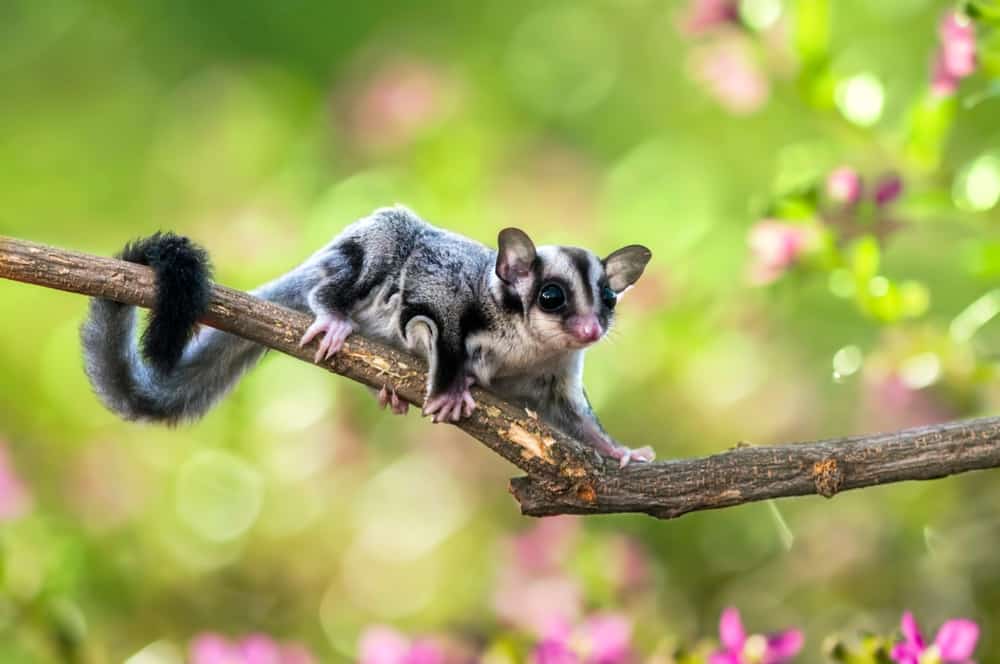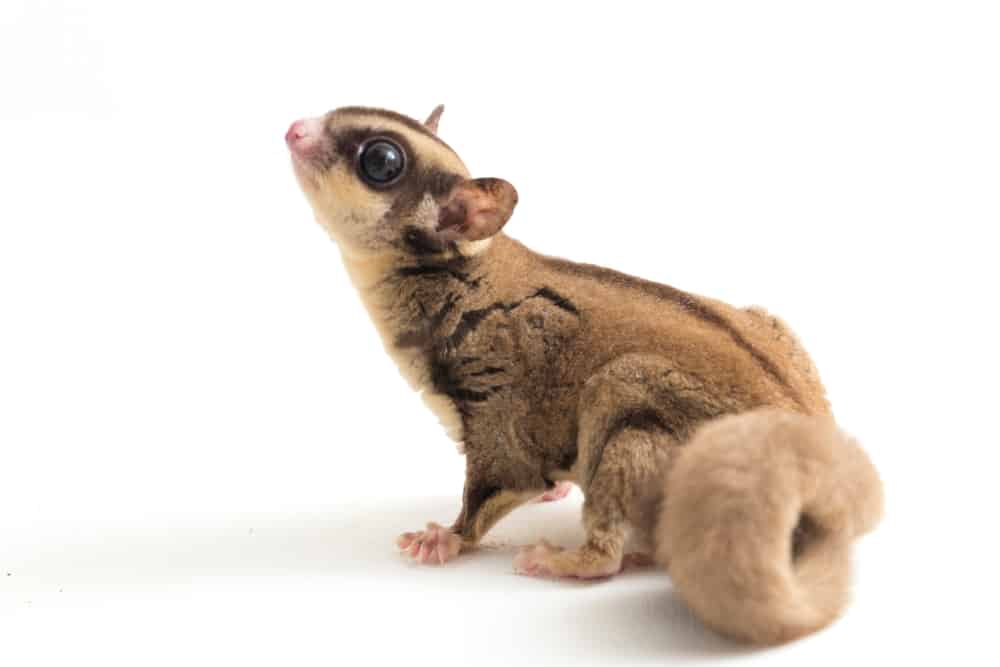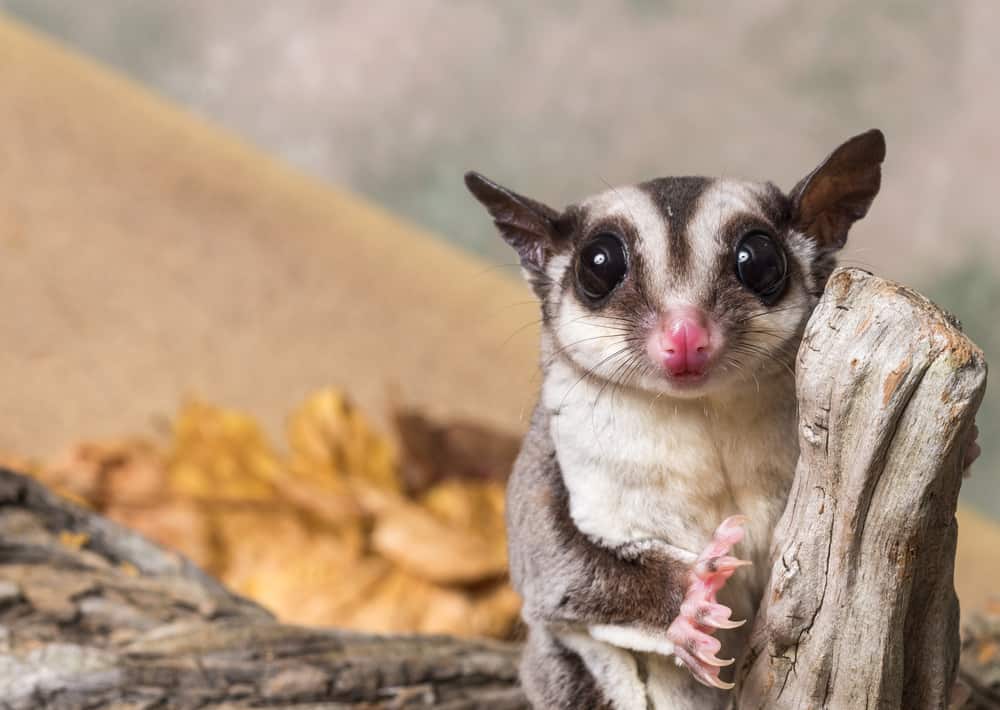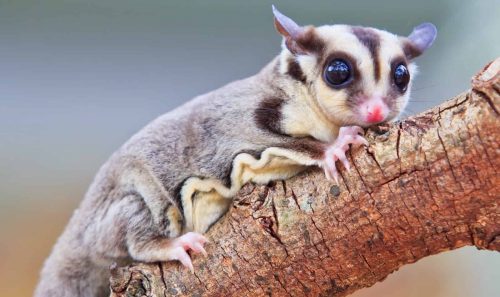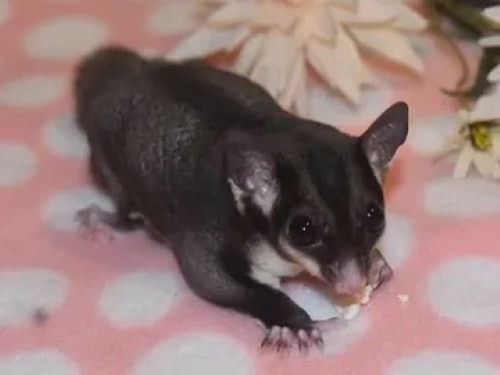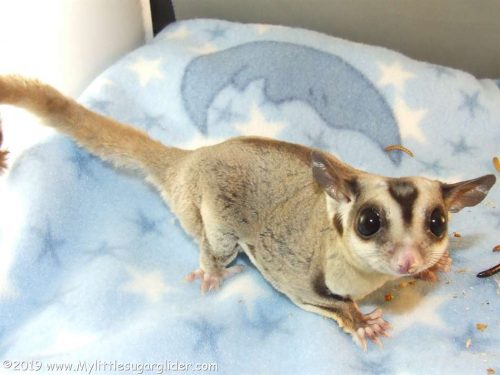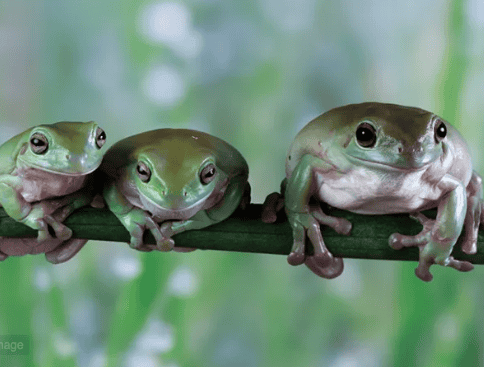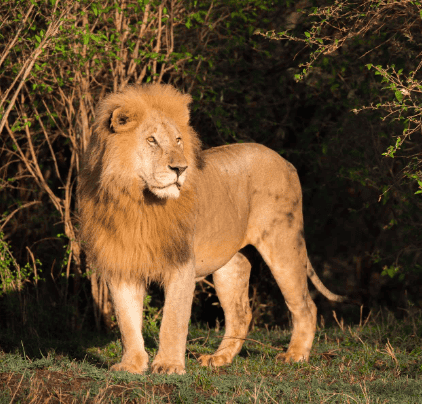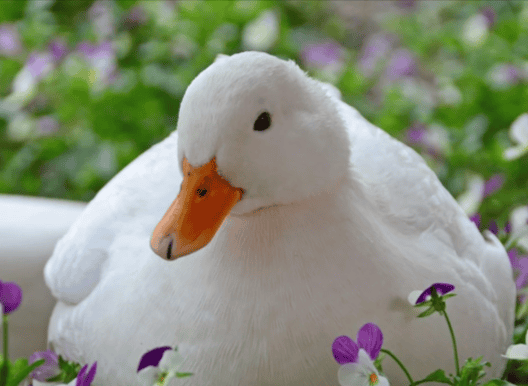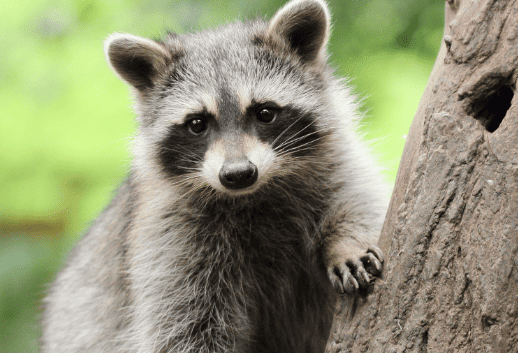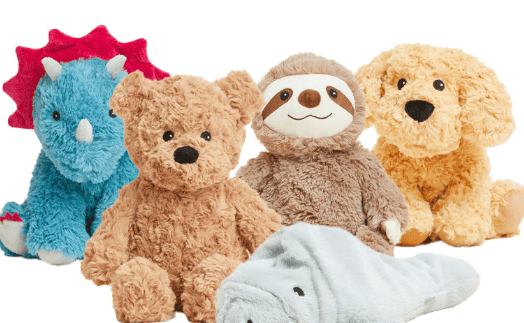Looking for an exotic pet? A sugar glider may be right for you.
Page Contents:
Overview
Sugar gliders are marsupials native to Australia and parts of Indonesia. They can grow up to 6 in. long and weigh up to 5.5 oz.
Like squirrels, gliders can have gray fur and black markings. In addition, gliders have a gliding membrane (thin, skin-like structure) that extends from the front to back limbs on each side. This membrane acts like wings, allowing gliders to move among trees.
A sugar glider has five digits on each foot. These digits allow it to maintain a firm grip on branches or a tree trunk.
Let’s not forget about a sugar glider’s rudder-like tail, either.
A glider’s tail is nearly 1.5 times as long as its body. It is often used to help a glider carry leaves to its nest.
Breeds of Sugar Gliders
Clearly, there’s a lot to like about sugar gliders. Yet, like any exotic pet, gliders are not right for everyone.
We’re here to teach you about gliders and what to expect if you get one as a pet.
Here are some of the most common types of Sugar Gliders.
1. Standard Gray Gliders
The most common coloration for sugar gliders. Their fur is primarily gray, with a dark stripe running from the top of their head all the way down to their tail. Dark patches of fur around the ears and eyes are also common.
2. Black Beauty Sugar Gliders
Black Beauty gliders are a variation of the Standard Gray coloring. Their fur is dark gray in color, sometimes bordering on black. Black Beauties have slightly different patterns on their fur, too: they have black knuckles and a “chin strap” running down their ears and past their eyes.
3. Mosaic Sugar Gliders
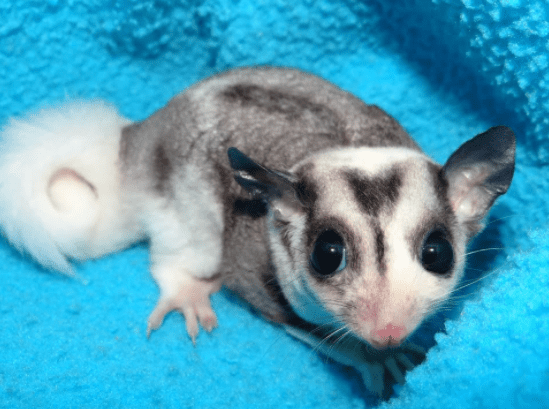
In the world of sugar gliders, mosaics are patterns broken up by white or another color. Among the more well known are:
Creamino Mosaic are sugar gliders whose coat displays two colors simultaneously.
Mahogany Red sugar gliders have a red coloration.
Piebald Mosaics are distinct fur patterns that show up as spots, beauty marks, or other symmetrical markings.
Ringtails Mosaics can be of any colored mosaic broken up by white and rings on the tail.
Reverse Stripe Mosaics are mosaic varieties with a solid white line across the back or a partial stripe. Sugar glider stripes are typically dark, but in this case, it’s white.
Platinum Mosaics display two color traits, ranging from the light-colored Silverbellies to Red or Dark Platinum.
White Mosaic: white is the predominant color but may have a few light gray or dark gray markings. Breeders call little gray or black dots on their ears “Cow Ears.”
4. White Face Blonde Sugar Gliders
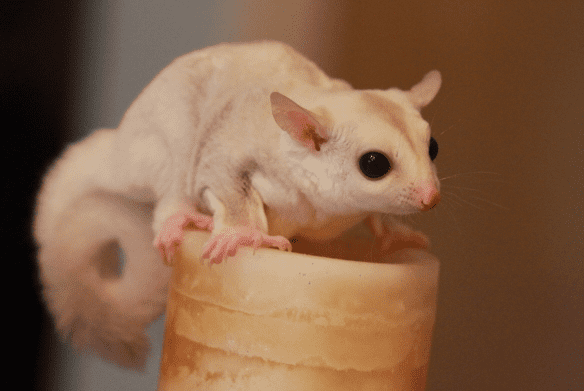
Whiteface blonde sugar gliders have light fur with a golden hue. Unlike other gliders, they don’t have a bar that extends under the ear toward the chin.
5. Platinum Sugar Gliders
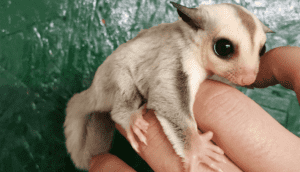
Platinum gliders have a white or light gray body with light to medium gray markings. These gliders also have a white collar and ring tail. And, they can sometimes have black/brown or brown eyes.
6. Ruby Platinum Sugar Gliders
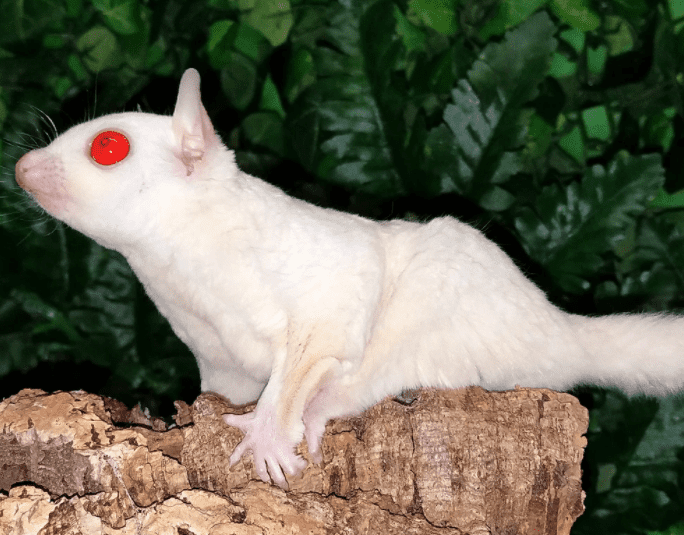
Ruby platinum sugar gliders are rare. They are solid white with red eyes. They are some of the most interesting-looking sugar gliders out there.
7. Albino Sugar Gliders
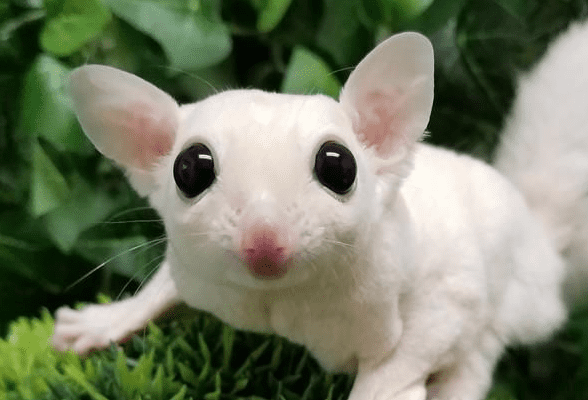
Albino gliders lack pigmentation. These gliders have white fur and red or black eyes. They can also have very faint markings.
8. Lion Sugar Gliders
These gliders are slightly different from most sugar glider breeds. They have more rounded faces and shorter noses, making their face shaped like a lion’s. Their fur is mostly gray, with a light honey-colored tint.
Are Sugar Gliders Dangerous to Humans?
Sugar gliders are social pets. They are not dangerous or aggressive towards humans.
However, humans can harm sugar gliders. If you’re not careful, you could inadvertently put your glider in danger.
Here are 3 tips to help you keep your glider happy and safe.
A. Play with Your Glider Every Day
Sugar gliders can get lonely, so you should try not to leave your pet on its own for too long. Spend at least a few minutes with your glider every day. This lets you bond with your glider. Over time, regular bonding helps your glider feel comfortable with you around.
B. Provide a Large Habitat for Your Glider
Give your sugar glider plenty of space to climb, run, and glide. You can even pick up hanging nests, small ladders, and other glider accessories. That way, your glider can play to their heart’s delight.
In the long run, your glider’s habitat will start to feel like a home.
C. Set Up a Shelter
Since gliders are nocturnal, they will need spots to hide in the dark during the day. So, you can set up a shelter where your glider can rest when the sun’s out. Try not to interrupt your glider while it sleeps, either. Otherwise, your glider is unlikely to have the energy necessary to play at night.
Be patient as your sugar glider gets acclimated to you and your home. Stay the course, and your glider will feel their best now and in the future.
Do Sugar Gliders Bite You?
Sugar gliders will bite if they feel threatened, provoked, or frightened. Common reasons why gliders bite include:
- Unfamiliar smells
- Self-defense
- Fear
Your glider may bite more frequently in the first few days or weeks as your pet. Baby gliders often go through a “teenage phase” in which they will bite anything that looks interesting.
These bites can be painful and take you by surprise, but they are usually not considered serious.
If your glider bites you, try not to panic. Instead, move past the incident and continue to bond with your glider.
As your glider starts to trust you, the biting will stop.
Finally, it is important to note that gliders are sap-suckers by nature. If you feed your glider by hand, you may be susceptible to bites.
When hand-feeding, you can guard against biting by keeping a steady supply of food close.
If you notice your hand getting empty, pick up more food. This ensures you can offer more food to your glider before it bites you.
Are Sugar Gliders Illegal?
As with any exotic pet, the legality of owning a sugar glider varies by state. Gliders are 100% legal to own in 41 states, with the remaining 9 states either completely prohibiting them or only allowing people to adopt sugar gliders with a permit.
For example, owning a sugar glider is illegal in these states:
- Alaska: Alaska has a “clean list” of animals that can be legally kept as pets. Sugar gliders are not included on this list, and therefore cannot be adopted in the state.
- California: Certain non-native species are illegal to own as pets in California, including sugar gliders. Since gliders are native to Australia, the state of California considers them wild animals and prohibits their adoption.
- Hawaii: The state of Hawaii considers sugar gliders and invasive species, and makes it illegal to own them in order to preserve the state’s ecosystem.
Before purchasing a sugar glider, make sure to check out your local laws – and only purchase from a reputable dealer/seller/.
Are Sugar Gliders Good Pets?
It depends on what you’re looking for in a pet.
The Good: Sugar Gliders may be good pets if properly cared for and paid attention to. If they get to like their owners, they are affectionate and playful. It’s best to have more than one to keep them occupied.
The Bad: They may bite their owners, particularly if they’re not used to being handled. These bites may be painful, as their teeth are sharp. They also may carry diseases. Sometimes, unscrupulous smugglers will capture wild silver gliders into the United States and sell them as pets.
The Cost: Creating a suitable habitat for your sugar glider may be expensive, as they require mental stimulation, attention, and encouragement to exercise – as much as a cat.
Housing sugar gliders: Their cage should be 24” by 24” by 36,” the cage bars should be no more than ½ inch apart by 1 inch.
Any wider spacing may risk them having a chance at escaping. Inside the cage, ladders and platforms will encourage the sugar glider to exercise. Fill their cage with a variety of toys to keep them occupied.
Thankfully, they can eat many of the everyday household groceries you would keep around the house anyway, such as eggs, fruit, and nuts.
Sugar gliders are a great pet option, but they take some work! If you think you want to look into making a new friend at home, sugar gliders can be a fun option!
